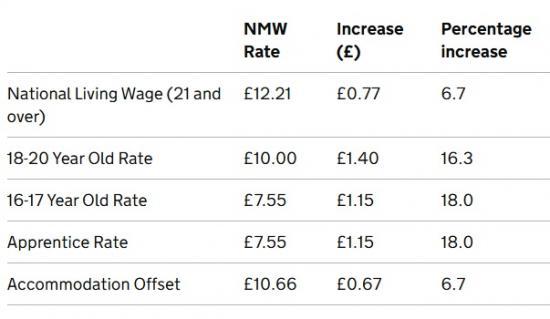National Living Wage to increase to £12.21 in April 2025
30th October 2024

Since 1 April, employees aged 21 and over have been entitled to the National Living Wage. Previously, you had to be 23 to qualify.
It is currently worth £11.44 an hour, but will increase to £12.21 in April 2025.
The pay rates are set by the government every year on the advice of an independent group, the Low Pay Commission, external.
It had recommended that the National Living Wage should be £12.10 in April 2025, a 5.8% rise, external.
However, the government has announced that the rate will increase by 6.7%.
Younger employees - aged between 16 and 20, external - receive the National Minimum Wage.
For 18, 19 and 20-year-olds, the National Minimum Wage is £8.60, but will rise to £10 an hour in April 2025.
That is the largest rise on record, and is the first step towards meeting the government's target of having a single adult rate.
For 16 and 17-year-olds, the National Minimum Wage is £6.40 an hour. The government has not yet confirmed what this rate will be in April 2025.
The separate apprentice rate,, external which applies to eligible people under 19 - or those over 19 in the first year of an apprenticeship will rise from £6.40 to £7.55, an 18% increase.
Employers must implement the new rates by 1 May 2025.
The LPC's recommendations meet the remit set by the Government. The recommended NLW rate is expected to equal two-thirds of median earnings and to have the highest real value in the history of the UK's minimum wage. The increase in the 18-20 Year Old Rate narrows the gap between that and the NLW, in anticipation of the adult rate being extended to 18 year olds in future years.
Baroness Philippa Stroud, Chair of the LPC, said:
The Government have been clear about their ambitions for the National Minimum Wage and its importance in supporting workers’ living standards. At the same time, employers have had to deal with the adult rate rising over 20 per cent in two years, and the challenges that has created alongside other pressures to their cost base.
It is our job to balance these considerations, ensuring the NLW provides a fair wage for the lowest-paid workers while taking account of economic factors. These rates secure a real-terms pay increase for the lowest-paid workers. Young workers will see substantial increases in their pay floor, making up some of the ground lost against the adult rate over time.
The data show some signs of employers finding it harder to adapt to minimum wage increases. The tightening of the labour market since the pandemic has unwound, but the overall picture is similar to 2019.The economy is expected to grow over the next year, although productivity growth remains subdued.
We look forward to continuing our work next year as the detail of the Make Work Pay plan is elaborated upon. The NMW is a major part of the Government’s ambitions for the future of the labour market, and it is important that it continues to be informed by the expertise and consensus-building the LPC provides.
The LPC’s recommendations are based on extensive consultation with employers, workers, representatives of both groups and other expert bodies, as well as a series of regional visits across the UK. They reflect unanimous agreement among Commissioners, including those representing workers, employers and independent experts.
The recommended increase in the 16-17 Year Old Rate restores that rate to its original value relative to the adult minimum wage. In line with previous recommendations, the Apprentice Rate will remain equal to the 16-17 Year Old Rate.
Notes for editors
The LPC’s recommendations were submitted to the Government on 25 October 2024. The Government has today announced acceptance of those recommendations.
The LPC will on Wednesday 30 October publish its letter of recommendations to the Government and a short report summarising the main evidence Commissioners relied on to make those recommendations. The LPC’s full annual report will be laid before Parliament and published in the new year.
The Government’s remit to the LPC, which determines the Commission’s work through the year, was published in July and is available here.
The LPC’s recommended NLW rate is intended to meet the Government’s ambition for this rate to reach at least two-thirds of median earnings in 2024.
For the first time, the Government asked the LPC to take into account the cost of living, including expected trends in inflation up to March 2026, when recommending the NLW. The LPC expects its recommended rate to represent a real-terms increase across the whole of the period to March 2026, using any major inflation measure, thereby protecting low-paid workers’ living standards.
